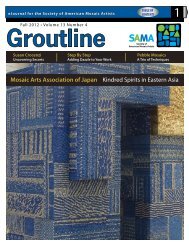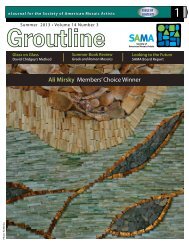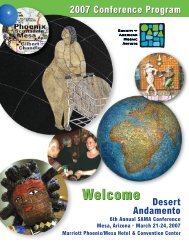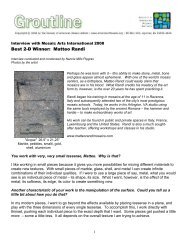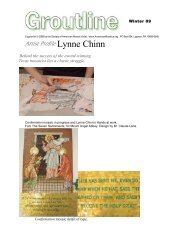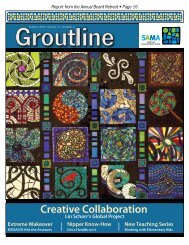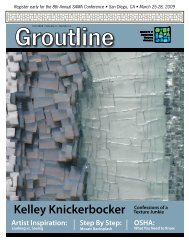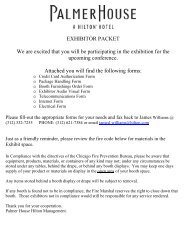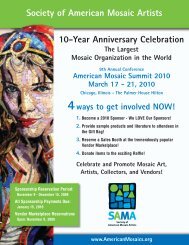Mireille Swinnen Interdisciplinary Art - Society of American Mosaic ...
Mireille Swinnen Interdisciplinary Art - Society of American Mosaic ...
Mireille Swinnen Interdisciplinary Art - Society of American Mosaic ...
Create successful ePaper yourself
Turn your PDF publications into a flip-book with our unique Google optimized e-Paper software.
Table <strong>of</strong><br />
1<br />
eJournal for the <strong>Society</strong> <strong>of</strong> <strong>American</strong> <strong>Mosaic</strong> <strong>Art</strong>ists ContentS<br />
Spring 2013 • Volume 14 Number 2<br />
1<br />
Colorado <strong>Mosaic</strong> <strong>Art</strong>ists<br />
30 Members and Growing<br />
Shipping Internationally<br />
What You Need to Know<br />
Wet Saws<br />
Types, Tips, and Tricks<br />
<strong>Mireille</strong> <strong>Swinnen</strong> <strong>Interdisciplinary</strong> <strong>Art</strong><br />
Photo: <strong>Mireille</strong> <strong>Swinnen</strong>
eJournal for the <strong>Society</strong> <strong>of</strong> <strong>American</strong> <strong>Mosaic</strong> <strong>Art</strong>ists<br />
2<br />
President’s Column<br />
I was exhausted yet exhilarated after<br />
attending the twelfth annual <strong>American</strong><br />
<strong>Mosaic</strong> Summit in Tacoma, Washington. This year’s attendance-breaking group wasn’t<br />
disappointed when they arrived. The Pacific Northwest hosting committee rolled out the red<br />
carpet, planning mosaic tours and even a trip to the Spectrum Glass Factory. The tours, the<br />
wonderful workshops, the unbelievable MAI Exhibition at the stunning Museum <strong>of</strong> Glass, and<br />
the presentations by well-known artists all made the conference unforgettable. Topping if <strong>of</strong>f<br />
was the SAMA Mini-Salon, exhibiting approximately 140 pieces <strong>of</strong> mosaic art and breaking<br />
yet another record.<br />
Photo: Tim Stassines<br />
The 2013 <strong>American</strong> <strong>Mosaic</strong> Summit in Tacoma, Washington,<br />
has come to a close. Thanks to all the volunteers who chipped<br />
in to make it an overwhelming success.<br />
Inside Spring 2013<br />
President’s Column 2<br />
Lead StorY<br />
Shipping Internationally 9–10<br />
Departments<br />
Inspiration<br />
Secret Confessions <strong>of</strong> a Collector 3<br />
Regional<br />
Colorado <strong>Mosaic</strong> <strong>Art</strong>ists 4<br />
<strong>Art</strong>ist Pr<strong>of</strong>ile<br />
<strong>Mireille</strong> <strong>Swinnen</strong> 5<br />
Step By Step<br />
Cutting Glass with a Wet Saw 6<br />
Ask a Pro<br />
Dalle de Verre 8<br />
SAMA NEWS<br />
2013 Contributors 11<br />
Volunteer <strong>of</strong> the Year 11<br />
SAMA Leadership 12<br />
Our keynote speaker, Japan’s Toyoharu Kii, charmed and inspired us not only through<br />
his presence at the conference and his informative presentation, but also through his art,<br />
displayed in the museum alongside that <strong>of</strong> our members. We hope to forge a lasting bond<br />
between SAMA and the <strong>Mosaic</strong> <strong>Art</strong> Association in Japan (MAAP).<br />
At the general meeting, SAMA honored Karen Ami, President Emeritus and eight-year<br />
board member, who is stepping away from the Board <strong>of</strong> Trustees to concentrate on her<br />
artwork. We owe Karen a huge debt <strong>of</strong> gratitude for her passionate service, and I hope you<br />
will join me in thanking Karen for her devotion and support. Fortunately, she will continue to<br />
serve as an integral part <strong>of</strong> the exhibitions committee. While we will miss her on the board,<br />
we look forward to the new art that will be emerging from Amiba Studio. Thank you, Karen,<br />
for a job well done!<br />
The conference concluded on Saturday with the annual raffle and the first-ever “Have a<br />
Ball for SAMA” dinner and auction. Amber Pierce conducted the raffle this year, beginning<br />
with an impassioned plea for everyone to donate $5. From all corners <strong>of</strong> the room, people<br />
streamed to the front and placed money on the podium. In less than five minutes, donations<br />
totaled $2,400! That night, “Have a Ball” attendees enthusiastically bid on the donated items,<br />
raising nearly $10,000 for SAMA’s general fund.<br />
What a night, what a week, what a conference! I thank each <strong>of</strong> you personally for<br />
supporting our organization, and I hope to see you in Houston next year!<br />
Find us! facebook.com/americanmosaics<br />
Follow us! twitter.com/americanmosaics<br />
Join and learn more! americanmosaics.org<br />
Shug Jones<br />
In addition to being president <strong>of</strong> SAMA, Shug Jones is the president/founder <strong>of</strong><br />
Tesserae <strong>Mosaic</strong> Studio, Inc. in Richardson, Texas, where she creates fine mosaic art<br />
and installations and <strong>of</strong>fers classes and workshops. tesseraemosaicstudio.com<br />
ON THE COVER : . Charlotte, by <strong>Mireille</strong> <strong>Swinnen</strong>, 2011. 10”H x 13”W. Smalti. Privately owned by the<br />
artist’s daughter, Sara Veestraeten.
eJournal for the <strong>Society</strong> <strong>of</strong> <strong>American</strong> <strong>Mosaic</strong> <strong>Art</strong>ists<br />
Table <strong>of</strong><br />
ContentS<br />
3<br />
INSPIRATION<br />
Secret Confessions <strong>of</strong> a Collector<br />
by Barbara Dybala<br />
Are you a collector? Not a person who acquires fine<br />
art, but a collector <strong>of</strong> glass, tile, smalti, stones, tools,<br />
found objects, broken pieces? A good way to find<br />
out is to sell your home and move your studio and<br />
all its supplies. If your boxed-up studio fills more<br />
space on the moving truck than the combined contents <strong>of</strong> your<br />
living room, dining room, and kitchen, then you are a collector.<br />
“But no, not me!” I thought. I convinced my sweet husband<br />
that every square inch <strong>of</strong> glass and tile was needed for that<br />
someday project, but I secretly asked myself, “Am I a collector<br />
<strong>of</strong> sales items, leftover glass, broken dishes?” I have major art<br />
projects under my belt, but the roomful <strong>of</strong> mosaic “wannabe”<br />
products made me gasp in disbelief. I wondered sadly whether<br />
that was all my mosaic classes and travels had been about.<br />
At that moment, Raymond Isidore, Antoni Gaudi, and<br />
Friedensreich Hundertwasser came to mind. Mentally and<br />
physically, I experienced a breakthrough mosaic moment and<br />
a heartfelt creative release: “I’m going to use up all my random<br />
glass, tile, smalti, and plates, as well as try out that Diamond<br />
Laser 7000 Heavy Duty Wet Band Saw I just ‘had to buy’ on<br />
craigslist!” I thought excitedly.<br />
Photo: Gary Coots<br />
Entwined, by Barbara Dybala, 2012. 18’H x 15’W x 3”D. Stairway wall. Glass, mirror, plates,<br />
saucers, figurines, coins, smalti, and porcelain. The handrail is a 2-by-4 piece <strong>of</strong> lumber<br />
adorned with signatures <strong>of</strong> all who have ascended the stairs.<br />
Suddenly I looked up, and there it was: a fresh, new, 18-by-15-foot stairway wall. Suspended from the ceiling above the landing, an<br />
oversized, 3-foot-round light fixture glowed, showing me the way. Slowly, as I lifted my hand and followed the light’s circumference with<br />
my index finger, I repeated the mantra <strong>of</strong> a game played on countless summer nights: “The moon, the moon, the great big moon. Two eyes,<br />
a nose, and a mouth.”<br />
At that point, I didn’t even need a knife to open all those boxes. I began ripping and tearing—nothing would stop me. It had begun.<br />
One day … three days … twelve days and nights. Scissors lifted, mesh, glue—it was exhilarating—glass flying. “I’m on fire!” I thought.<br />
A few Band-Aids to cover nicks, a pain pill for my back. I was obsessed; already, the project was too big to photograph.<br />
Finally, stepping back, I was done. Peace and freedom filled me. “Someday,” I thought, “I may even grout it.”<br />
Barbara Dybala, mosaic entrepreneur and optimist, is currently building the <strong>Mosaic</strong> Sculpture Garden Studio and Shop in Rockwall, Texas. There she works with a landscape architect<br />
to create custom mosaics; she also holds mosaic workshops and classes. She lives in a land where all colors match, and a weed is just another lovely flower.<br />
pieceloveandsmalti.com, barbaradybala.com
Table <strong>of</strong><br />
14<br />
eJournal E-Journal for the <strong>Society</strong> <strong>of</strong> <strong>of</strong> <strong>American</strong> <strong>Mosaic</strong> <strong>Art</strong>ists<br />
ContentS<br />
REGIONAL<br />
Colorado IS <strong>Mosaic</strong><br />
by Deborah Williams and Kathy Thaden<br />
As we prepare for our September 2013 regional exhibition,<br />
we can’t help but reflect on how our Colorado <strong>Mosaic</strong> <strong>Art</strong>ists<br />
(CMA) community is like a giant mosaic itself. From our initial<br />
sketch to our upcoming exhibition, the layers <strong>of</strong> creativity<br />
build upon each other until what’s revealed surprises even us!<br />
It’s been nearly a decade since a small group <strong>of</strong> mosaic artists formed<br />
CMA, a successful not-for-pr<strong>of</strong>it association dedicated to the promotion and<br />
education <strong>of</strong> mosaic as fine art.<br />
Many <strong>of</strong> CMA’s founding members were part <strong>of</strong> an international online<br />
forum, which led to the desire to meet in person. Sharing ideas and<br />
encouraging each other with all things possible is how it started, and how<br />
it’s kept going and growing. CMA President Kathy Thaden commented, “You<br />
can learn a great deal online and from books, but meeting in person and<br />
seeing each other’s art is exciting and stimulating.”<br />
We have about 30 members in our group, and our active board <strong>of</strong><br />
directors includes a president, vice president, secretary, and treasurer. We<br />
meet once a month in homes or studios, and we alternate agendas <strong>of</strong> handson<br />
activities with business or educational topics. And, as Colorado mosaic<br />
artists, we’re fortunate to enjoy an annual summer retreat at a member’s<br />
fabulous mountain abode in Breckenridge. Grout dries quickly at 8,000 feet!<br />
In September 2012, we adopted a formal mission statement that ensures<br />
our support and advocacy for mosaic art in Colorado,<br />
encourages mosaic artists to grow through meetings and events, gives<br />
visibility to the mosaic art form by providing exhibit opportunities, and<br />
contributes to the community by donating mosaic art to recognized<br />
charitable organizations.<br />
For a recent charitable project, we created a mosaic quilt for Project<br />
Angel Heart, a local non-pr<strong>of</strong>it that delivers nutritious meals at no cost<br />
to people coping with life-threatening illnesses. A team <strong>of</strong> three<br />
spearheaded the logistics and created the design; 14 more members<br />
each contributed a section <strong>of</strong> the mosaic. Now visitors, volunteers, and<br />
staff enjoy the prominently displayed, proud representation <strong>of</strong> Project<br />
Angel Heart’s mission.<br />
As we strive to expand our exhibition opportunities, we’re excited<br />
to host our first regional show this September. Through our<br />
collaboration with Lakewood Cultural Center, we can provide a<br />
venue large enough to invite our neighbors from Idaho, Montana,<br />
Wyoming, Utah, New Mexico, and Arizona. The award-winning<br />
international mosaic artist Julie Richey is our esteemed juror<br />
(juliericheymosaics.com). Julie will also host a half-day pr<strong>of</strong>essional<br />
development workshop. The deadline for the fall exhibition is<br />
July 1, and you can find details online at coloradomosaics.org.<br />
Photos: Bob Taylor<br />
Created by 15 CMA members, this 72-square-foot mosaic “quilt” visually<br />
represents meals and other events provided by the Denver, Colorado,<br />
nonpr<strong>of</strong>it Project Angel Heart.<br />
Deborah Williams is a new member <strong>of</strong> CMA and SAMA. She looks forward to becoming a<br />
contributing member <strong>of</strong> this great community <strong>of</strong> mosaic artists. omgwhiz.etsy.com.<br />
A 2004 founding member, CMA President Kathy Thaden is also a Pr<strong>of</strong>essional Member <strong>of</strong><br />
SAMA. thadenmosaics.com<br />
Information sharing at a CMA meeting at Barbara Cohen’s studio in Denver,<br />
Colorado. Left to right: Marlea Taylor, Jean Wilson, Laurie Adams, Kathy Thaden,<br />
Cindy Miller, Joan Schubert, Lynnette Kupferer (hidden), Barbara Cohen, Barb<br />
Arne, and Misha Moore.
eJournal for the <strong>Society</strong> <strong>of</strong> <strong>American</strong> <strong>Mosaic</strong> <strong>Art</strong>ists<br />
Table <strong>of</strong><br />
ContentS<br />
5<br />
ARTIST PROFILE<br />
<strong>Mireille</strong> <strong>Swinnen</strong><br />
by Jane Denison<br />
<strong>Mireille</strong> <strong>Swinnen</strong> hesitantly describes<br />
herself as a child <strong>of</strong> the Spilimbergo<br />
school <strong>of</strong> mosaics. She hesitates because<br />
she also views her idiosyncratic work as<br />
incorporating the lessons <strong>of</strong> many<br />
mosaic artists.<br />
“I’m a sponge when it comes to learning,” she confesses.<br />
“I absorb whatever is around me.”<br />
The Belgian artist’s willingness to experiment with new<br />
techniques lends a unique vibrancy to her work. Following<br />
her first solo show in Los Angeles and the selection <strong>of</strong> her<br />
work Motherhood in the MAI exhibition, <strong>Mireille</strong> is rapidly<br />
gaining recognition in today’s mosaic art scene.<br />
<strong>Art</strong> has always featured prominently in <strong>Mireille</strong>’s life.<br />
From age 10, she attended art school, where she learned<br />
to draw, paint, and sculpt. Since taking up mosaics in<br />
2001, her focus has been to integrate her core artistic<br />
skills into her mosaic practice. Her work has led her into<br />
extensive study with artists from Spilimbergo, such<br />
as Ambrogio Zamparo, Mélaine Lanoë, Marie-Laure<br />
Besson, Carolina Zanotti, and Paola Gortan. In a series<br />
<strong>of</strong> workshops at Orsoni, she absorbed further lessons<br />
in working with smalti. She attributes her painterly and<br />
expressive style to the influence <strong>of</strong> both schools.<br />
The painterly effect is evinced in Motherhood, a<br />
composition that shows a mother bird proudly watching<br />
over her young. The subject is self-referential and<br />
concerns her identity as an adoptive mother. Foregoing<br />
the lines and rhythms usually seen in mosaics, <strong>Mireille</strong><br />
creates the sculptural form <strong>of</strong> the bird’s body through<br />
an ad hoc mix <strong>of</strong> tesserae that resemble an artist’s<br />
spontaneous brushstrokes. She also treats the young<br />
hatchlings in an unorthodox way by reducing their form<br />
to a series <strong>of</strong> open mouths conveyed through the irregular<br />
placement <strong>of</strong> pink smalti. The demanding mouths <strong>of</strong> the<br />
hatchlings, combined with their mother’s love and fiercely<br />
protective stance, show emotions familiar to all mothers.<br />
Photo: <strong>Mireille</strong> <strong>Swinnen</strong><br />
Motherhood, by <strong>Mireille</strong> <strong>Swinnen</strong>, 2012. 15”H X 17”W X 3”D. Smalti, rose quartz, gold smalti,<br />
driftwood. Currently on exhibit at the Museum <strong>of</strong> Glass in Tacoma, Washington.<br />
In another mosaic (see cover), <strong>Mireille</strong> projected the love for<br />
her daughter Sara through the eyes <strong>of</strong> Charlotte, a work that she<br />
made for Sara’s 21st birthday. It shows the technique she feels most<br />
comfortable with, working from pr<strong>of</strong>essional quality photographs, in<br />
this case <strong>of</strong> her daughter’s favorite pet. She translated the vivid colors<br />
and brighter areas using big chunks <strong>of</strong> smalti for maximum effect and<br />
contrast with the fuzzy detail <strong>of</strong> the dog’s fur.<br />
<strong>Mireille</strong>’s painterly style is also seen in Genesis, an adaptation<br />
<strong>of</strong> Jenny Saville’s Passage (2004). The flesh tones take on a sensory<br />
quality as large pieces <strong>of</strong> tesserae create a sculptural effect and draw<br />
attention to the lightest hues on the model’s abdomen and thighs.<br />
In contrast, the genitalia are partially obscured in a mass <strong>of</strong> shadows<br />
formed by small, irregularly shaped tesserae.<br />
<strong>Mireille</strong> sees a parallel between her subject and an artist’s struggle<br />
with (self-proclaimed) artistic identity: “The mosaic method, which is<br />
a form <strong>of</strong> deconstructing and reconstructing, is in itself a search for a<br />
new identity.”<br />
The artist’s desire to keep her own vision while learning from<br />
others has enabled her to develop a strong visual “language.” When<br />
you look closely at her work, you’ll see the brushstrokes <strong>of</strong> a painter,<br />
the form <strong>of</strong> a sculptor, and the skill <strong>of</strong> a mosaic artist.<br />
Learn more about <strong>Mireille</strong> at her studio site and on Facebook.<br />
Jane Denison, a freelance writer who specializes in art history, has a keen interest in mosaic art.<br />
janedenison@hotmail.com
eJournal for the <strong>Society</strong> <strong>of</strong> <strong>American</strong> <strong>Mosaic</strong> <strong>Art</strong>ists<br />
Table <strong>of</strong><br />
ContentS<br />
6<br />
STEP BY STEP<br />
Cutting Glass with a Wet Saw<br />
by Lou Ann Weeks<br />
Rosie the Riveter, a cultural icon for<br />
female factory workers during World War II,<br />
is still relevant for women today. Using hand<br />
tools to shape glass may not have daunted<br />
Rosie, but I know it’s frustrated me. Wet saws<br />
can help!<br />
Safety<br />
It’s important to follow all the safety instructions you receive when you purchase a<br />
wet saw. Do not remove blade guards or forget to use eye protection. Do not allow<br />
water to run down the power cord and into your socket or electrical connection: That<br />
could be a shocking experience!<br />
Types <strong>of</strong> Saws<br />
Most tile saws are “wet” saws. They have either an internal water pump and hose or a<br />
bottom water tray to cool the blade and reduce dust during operation. Here are three<br />
types <strong>of</strong> wet saws:<br />
Table Saws cut straight lines on very hard tiles such<br />
as porcelain, granite, and marble. The blade is a circular<br />
wheel that runs through a bottom water tray for cooling.<br />
Band Saws are perfect for precision cutting. The blade<br />
is a long, narrow, flat metal band with diamond cutting<br />
teeth on one side. It cuts granite and marble easily, and<br />
has specialty blades for cutting stained glass; the blade is<br />
cooled by the action <strong>of</strong> a water pump and hose.<br />
Tips & Tricks<br />
• Remember to coat your pattern marks with<br />
lip balm or beeswax to prevent them from<br />
washing <strong>of</strong>f the glass.<br />
• To save time and wear-and-tear on the saw,<br />
trim away excess material by hand before<br />
cutting on the saw.<br />
• Don’t force material into the blade. Allow the<br />
work to glide smoothly. Avoid twisting the<br />
blade on tight curves.<br />
• Don’t put cutting sludge down plumbing<br />
drains. The sludge from glass, stone, and tile<br />
may harden and clog the drain.<br />
• To back out <strong>of</strong> a cut, turn the saw <strong>of</strong>f and<br />
slowly ease the material away from the blade.<br />
• Protect your fingers with fingertip grips when<br />
guiding the glass through the saw blade.<br />
Ring Saws are versatile and portable. The blade, a<br />
narrow ring covered in diamond cutting teeth that can<br />
cut in any direction, runs through a water tray.<br />
How to Cut Shapes<br />
Draw your pattern on the glass with a marker in a color you can easily see. Coat your<br />
pattern marks with lip balm or beeswax to keep them from “floating” away when the<br />
water hits them.<br />
Straight cuts – Line up your pattern mark with the saw blade and use consistent<br />
pressure to guide the glass forward.<br />
Curves – Following the pattern, feed the glass slowly into the blade, gently turning.<br />
90-degree cuts – Easy to do with a ring saw; angle the glass sideways across the<br />
blade. With a band saw, turn the glass slowly until you can work the glass around the<br />
blade. Be careful not to twist the blade.<br />
Unusual shapes – Same as the 90-degree cut, but you may have to make numerous<br />
cuts in the glass to complete the shape.<br />
Lou Ann Weeks is the owner <strong>of</strong> Lou Ann Weeks, Inc., an Orlando, Florida, mosaic business specializing in fine art,<br />
large installations, teaching, and advancing the mosaic community. A SAMA member since 2002, Lou Ann will be<br />
instructing in technical workshops at the April 2013 conference. louannweeks.com
eJournal for the <strong>Society</strong> <strong>of</strong> <strong>American</strong> <strong>Mosaic</strong> <strong>Art</strong>ists<br />
Table <strong>of</strong><br />
ContentS<br />
7<br />
Worry-Free<br />
Protection<br />
For Your<br />
Work <strong>of</strong> <strong>Art</strong>.<br />
“Ocean(egg)raphy” copyright 2008-2009 Dianne Sonnenberg <strong>Mosaic</strong>s I Photograph: Coleman Jennings<br />
SPectrALOcK ® PrO Premium Grout *<br />
Offering consistent color that will not fade or crack, SpectraLOcK ®<br />
prO premium Grout * protects your mosaic art by providing a<br />
stainpro<strong>of</strong>^^, non-sag installation. choose from 40 vibrant colors<br />
with an optional SpectraLOcK DazzLe component for over 200<br />
color options, including metallic and glow-in-the-dark.<br />
www.laticrete.com l 1.800.243.4788<br />
*United States Patent No.: 6881768 (and other Patents) ^^StainPro<strong>of</strong> (residential installation only) to common household cleaners, liquids and other goods. Clean all spills immediately.<br />
A-5262-0313 ©2013 LATICRETE International, Inc. All trademarks shown are the intellectual properties <strong>of</strong> their respective owners.<br />
Globally Proven<br />
Construction Solutions
eJournal for the <strong>Society</strong> <strong>of</strong> <strong>American</strong> <strong>Mosaic</strong> <strong>Art</strong>ists<br />
Table <strong>of</strong><br />
ContentS<br />
8<br />
ASK A PRO<br />
Dalle de Verre<br />
by sophie drouin<br />
Photos: Sophie Drouin<br />
Above is an example <strong>of</strong> a dalle de verre and mosaic combination that can be hung in<br />
a window. In the top photo, the light source is behind it, and in the middle photo, the<br />
light source is in front. Bottom photo: A faceting hammer.<br />
Q. I have seen more and more mosaics that use dalle de verre.<br />
How is it cut, and what is the best way to use it?<br />
A. Dalle de verre is French for “pave glass” or “slab <strong>of</strong> glass,”<br />
and indeed it is, simply put, a slab 1 inch thick, 8 inches wide and<br />
12 inches long, weighing in at around 8 lbs. Although this usually<br />
translucent glass is suitable for many types <strong>of</strong> mosaic, it’s mainly<br />
used as a form <strong>of</strong> stained glass, in a binder <strong>of</strong> either epoxy<br />
or concrete.<br />
Dalle can be cut with a wet saw, but this leaves the cut<br />
surfaces permanently scarred with abrasion residue. A carbidetipped<br />
hammer and hardie can actually do a better job. The<br />
initial cuts to reduce the large dalle to a more manageable size<br />
are accomplished with the hardie only. Wearing eye protection<br />
and fitted gloves, use one <strong>of</strong> the two pointed edges at the side <strong>of</strong><br />
the flat carbide hardie to hit the bottom side <strong>of</strong> the dalle at least<br />
a dozen times, creating a straight dotted line along the middle<br />
<strong>of</strong> its width. Then turn the glass over and hit it decisively on the<br />
hardie, aligning the flat blade with the series <strong>of</strong> hits you just<br />
made. It should break into two pieces. You can repeat this process<br />
until you are left with one-eighth <strong>of</strong> the initial slab, and then you<br />
can switch to your carbide hammer.<br />
The process <strong>of</strong> making a dalle de verre piece, suitable to hang<br />
in a window or even to fit as a window, takes days, and is much<br />
too lengthy to describe here. However, I should mention the use<br />
<strong>of</strong> a special tool: a faceting hammer, which looks like a miniature<br />
brick hammer, with a small carbide blade at one end <strong>of</strong> its head<br />
and a flat carbide tip at the other. It’s used to add texture to the<br />
exposed surface <strong>of</strong> the dalle pieces. The faceting for the flat tip<br />
travels farther along the glass than the blade tip, making for<br />
variety in the resulting surfaces created.<br />
You can purchase dalles from Blenko Glass in West Virginia<br />
or Kokomo Opalescent Glass in Indiana. Blenko sells the carbide<br />
faceting hammers in store, but you can find them online at<br />
Kraft Tool Co.<br />
Sophie Drouin is a Canadian second-generation mosaic artist who teaches throughout<br />
North America. She has exhibited at SAMA’s MAI exhibitions every year since joining<br />
the group, winning awards within SAMA and in the U.S. as well as in Europe. She<br />
is the editor for the English version <strong>of</strong> the French publication Mosaïque Magazine.<br />
sophiemosaics.com
eJournal for the <strong>Society</strong> <strong>of</strong> <strong>American</strong> <strong>Mosaic</strong> <strong>Art</strong>ists<br />
Table <strong>of</strong><br />
ContentS<br />
9<br />
LEAD STORY<br />
The Ins and Outs <strong>of</strong> International Shipping<br />
by Shug Jones<br />
9<br />
further afield to exhibit their works face a myriad<br />
<strong>of</strong> international shipping challenges. If you’re<br />
<strong>Mosaic</strong> artists in North America who venture<br />
sending work overseas, you can benefit from the<br />
experience <strong>of</strong> several SAMA members.<br />
Last spring, I received an invitation to show work in an<br />
exhibition in Italy. What an exciting proposition! I immediately<br />
responded with a resounding “YES!” and set about having my<br />
work photographed for the catalog. The Italian gallery’s delivery<br />
deadline was in August, so I wasn’t in a rush to investigate<br />
shipping. I expected it to cost a few hundred dollars and<br />
imagined setting up an online shipment with UPS or FedEx, with<br />
a printed shipping label included. That’s how I’d always shipped<br />
my work to exhibitions in the United States, and the gallery in<br />
Italy had suggested this method.<br />
Boy, was I ever wrong! I sat down at my computer in early<br />
August to find the least expensive way to ship my mosaic. My<br />
package was 35 inches wide by 36 inches long by 5 inches deep.<br />
I was shocked to find that the shipping alone—one way—was<br />
$860. I was facing $1,720 round trip, plus customs charges and<br />
probably other fees as well. That really gave me pause. I hadn’t<br />
even figured in my insurance cost yet.<br />
Researching customs, I learned that I could request the<br />
landed charges (includes shipping, customs, and all fees) while<br />
setting up my shipment. Imagine my horror when I discovered<br />
that the one-way landed charges would be $4,500! If my mosaic<br />
sold at the exhibition, the valued price <strong>of</strong> $2,800 wouldn’t even<br />
cover the shipping. How disheartening. At this point, I seriously<br />
considered backing out <strong>of</strong> the exhibition.<br />
I reached out to Lynn Adamo, who was also invited to the<br />
exhibition. She was in the process <strong>of</strong> arranging shipping, and her<br />
experience was similar to mine. Lynn had consulted other artists<br />
who’d shipped work to Italy; several were in this exhibition. What<br />
resulted was a group <strong>of</strong> five artists keeping in touch over a threemonth<br />
period to document the journey <strong>of</strong> our artwork to Italy<br />
and back.<br />
Photo: PhotoDic, Beyond Retro, 2B Custom Publishing<br />
The ATA Carnet<br />
Most governments don’t have international agreements<br />
that allow artwork to travel easily from one country to<br />
another on loan to exhibitions. The only solution is the<br />
ATA Carnet, a passport for goods traveling to another<br />
country and returning within a certain amount <strong>of</strong> time.<br />
(A carnet is not recommended for work that will be sold<br />
overseas.) Although the carnet helps grease the wheels <strong>of</strong><br />
bureaucracy, it’s an expensive option beyond the cost <strong>of</strong><br />
crating, shipping, and insuring. A carnet can be obtained<br />
from a company specializing in international trade. Those<br />
in our group who purchased carnets used two companies.<br />
For detailed information, visit Boomerang Freight<br />
Solutions or Roanoke Trade.<br />
It’s important to choose a shipping company that’s<br />
accustomed to working with carnets. FedEx and UPS are not<br />
the way to go. I chose DHL because: 1) they’re familiar with<br />
the carnet process, 2) they have the ability to set up export<br />
and import accounts, which meant I would get discounts<br />
on the shipping, and 3) having an import account eased the<br />
process <strong>of</strong> returning the shipment to me at the conclusion <strong>of</strong><br />
the exhibition.<br />
Continued on page 10
Table <strong>of</strong><br />
10 9<br />
eJournal for the <strong>Society</strong> <strong>of</strong> <strong>American</strong> <strong>Mosaic</strong> <strong>Art</strong>ists ContentS<br />
continued – LEAD STORY<br />
The carnet remains with the shipment throughout<br />
the process, both outgoing and incoming. It’s stamped<br />
at each checkpoint. When the shipment is returned to<br />
you, the carnet is returned to the place from which it<br />
was obtained.<br />
The carnet’s price is based on the value <strong>of</strong> the goods<br />
listed on it. My ATA Carnet listed my mosaic along with<br />
the work <strong>of</strong> my business partner, Julie Dilling, which<br />
was part <strong>of</strong> the same shipment. After we completed the<br />
application and it was accepted, we paid $398.48. This<br />
covered the basic carnet fee, surety bond fee, electronic<br />
import <strong>of</strong> product list fee, warranty fee, convenience fee,<br />
and handling and tracking fee. Then there was the fee <strong>of</strong><br />
$45.49 to overnight the carnet to us.<br />
There’s much more to this story, so visit the SAMA<br />
website for a checklist <strong>of</strong> things to consider.<br />
Special thanks to the following SAMA members who contributed<br />
to this story by sharing their experiences: Lynn Adamo,<br />
Sophie Drouin, Kate Kerrigan, Kelley Knickerbocker, Julie Richey,<br />
Lin Schorr, Carol Shelkin, Carol Talkov, and Kim Wozniak.<br />
CMSGroutline_15C_FINAL.pdf 12/28/12 6:52:37 PM<br />
Shug Jones, a mosaic artist/instructor working at her studio in Richardson,<br />
Texas, looks forward to shipping with fewer hassles in the future.<br />
tesseraemosaicstudio.com<br />
VISITING ARTISTS<br />
2013<br />
Toyoharu<br />
KII<br />
APRIL<br />
Margo<br />
ANTON<br />
MAY<br />
Carol<br />
SHELKIN<br />
MAY<br />
Antonella<br />
GALLENDA<br />
VIA ORSONI<br />
JUNE<br />
Guilio<br />
MENOSSI<br />
JULY<br />
Verdiano<br />
MARZI<br />
SEPTEMBER<br />
Please visit<br />
chicagomosaicschool.com<br />
for the latest updates about these<br />
workshops and more!<br />
773-975-8966<br />
chicagomosaicschool.com<br />
Advancing Education in Classical & Contemporary <strong>Mosaic</strong> <strong>Art</strong>s<br />
To Exhibit or Not to Exhibit?<br />
An invitation to exhibit internationally is both an<br />
honor and an opportunity. But before you give that<br />
resounding “YES!” ask yourself these questions:<br />
• Will listing this exhibition on my résumé be worth the<br />
time, expense, and stress?<br />
• Can I afford to pack and crate my work properly and<br />
obtain a carnet, documents, insurance, customs,<br />
and shipping?<br />
• Can the money spent on shipping take the place <strong>of</strong><br />
advertising dollars spent to promote workshops or<br />
classes over the Internet?<br />
• How would I feel if I put a lower insurance valuation<br />
on my work to avoid the expense <strong>of</strong> paying a<br />
high value-added tax (VAT), and then the mosaic<br />
is damaged?<br />
• After expenses, will I benefit financially if I sell the<br />
piece at the exhibition or after its return?*<br />
*If you use a carnet to ship your work and it sells at the<br />
exhibition, the carnet is subject to a penalty <strong>of</strong> an additional<br />
10 percent <strong>of</strong> the duties and taxes. A USCIB Claims Handling<br />
Fee may also apply.<br />
“A” Cut<br />
is<br />
back<br />
in stock!<br />
Modern and<br />
Antique Pallet<br />
Visit us at: pieceloveandsmalti.com
eJournal for the <strong>Society</strong> <strong>of</strong> <strong>American</strong> <strong>Mosaic</strong> <strong>Art</strong>ists<br />
Table <strong>of</strong><br />
ContentS<br />
11<br />
sama news<br />
As we pile our suitcases back into<br />
the closets and carefully arrange<br />
our Vendor Marketplace purchases<br />
among our studio stashes, let’s<br />
remember that we have two<br />
special people to thank for the<br />
conference memories: Kelley<br />
Knickerbocker and Richard Davis,<br />
SAMA’s 2013 Volunteer <strong>of</strong> the<br />
Year recipients.<br />
More than two years ago, both<br />
made a commitment to bring the<br />
2013 <strong>American</strong> <strong>Mosaic</strong> Summit<br />
to Tacoma. With the help<br />
<strong>of</strong> SAMA staff members<br />
Dawnmarie Zimmerman and<br />
Chris Forillo and firm support<br />
from the Board <strong>of</strong> Trustees,<br />
Kelley and Richard forged ahead.<br />
The result was the most highly attended conference ever!<br />
Kelley and Richard are quick to credit the galvanizing force<br />
<strong>of</strong> the Pacific Northwest volunteers, who enthusiastically <strong>of</strong>fered<br />
their time and talents. These volunteers not only increased<br />
SAMA membership in the region but also enhanced <strong>of</strong>ferings<br />
VOLUNTEERs <strong>of</strong> the year<br />
Richard Davis and Kelley Knickerbocker<br />
President’s Circle<br />
LATICRETE International<br />
Smalti.com<br />
Museum <strong>of</strong> Glass<br />
Photo: Donna Post<br />
Perdomo Smalti <strong>Mosaic</strong>os Bizantinos<br />
Bedrock Industries<br />
Gold Circle<br />
WitsEnd <strong>Mosaic</strong><br />
Silver Circle<br />
SAMA Board <strong>of</strong> Trustees<br />
Bronze Circle<br />
<strong>Mosaic</strong><strong>Art</strong>istsOrg@Yahoo<br />
MOSAICO Houston<br />
Thank You, 2013 SAMA sponsors!<br />
MILLEFIORE<br />
The Chicago <strong>Mosaic</strong> School<br />
MARBLE<br />
JeanAnn Dabb<br />
GLASS<br />
Austin <strong>Mosaic</strong> Guild<br />
Glass Accessories International<br />
Sonia King<br />
Robert Severino<br />
PORCELAIN<br />
Phyllis Akmal<br />
Diamond Tech International<br />
Jim Price<br />
El Toro Restaurant<br />
Carole Choucair Oueijan<br />
Tiny Pieces<br />
Jamie Pink Weisbrod<br />
by organizing additional tours and<br />
exhibitions.<br />
“I am very proud <strong>of</strong> the changes<br />
we made for the Tacoma conference,”<br />
Richard said, “especially beginning the<br />
<strong>Mosaic</strong> Marathon on Tuesday, holding<br />
the very successful fundraising dinner<br />
on Saturday, and <strong>of</strong>fering more tours<br />
on Wednesday and Thursday. I am so<br />
pleased about setting an attendance<br />
record, and I hope it’s a continuing sign<br />
<strong>of</strong> the resurgence <strong>of</strong> mosaic popularity<br />
for many years to come.”<br />
Kelly chimed in, “Over the last two<br />
years I’ve discovered what a large and<br />
thriving mosaic community we have right<br />
here in the Northwest (best volunteers<br />
ever!), rediscovered the vitality <strong>of</strong> Tacoma,<br />
enjoyed the hardest-working co-chair imaginable (you rock,<br />
Richard!), and spent a week steeped in mosaic appreciation and<br />
education along with more than 500 other practitioners and<br />
enthusiasts. I came away incredibly inspired and grateful.”<br />
Let’s all join in with a heartfelt “thank you” to Kelley and<br />
Richard for a spectacular job.<br />
–Donna Post<br />
Sustaining Contributors Tessera ContributorS gift Bag Contributors<br />
Austin <strong>Mosaic</strong> Guild<br />
Diamond Tech International<br />
El Toro Restaurant<br />
GAI / Morton Glass Works / No Days<br />
Judy Lee <strong>Mosaic</strong>s<br />
LATICRETE International<br />
Maverick <strong>Mosaic</strong>s<br />
<strong>Mosaic</strong><strong>Art</strong>istsOrg@Yahoo<br />
MOSAICO Houston<br />
NGlassworks<br />
Piece, Love and Smalti<br />
SAMA Board <strong>of</strong> Trustees<br />
Smalti.com<br />
SWH <strong>Art</strong> Studio Inc.<br />
The Chicago <strong>Mosaic</strong> School<br />
The Swiss Restaurant & Pub<br />
Uroboros Glass<br />
WitsEnd <strong>Mosaic</strong>
Table <strong>of</strong><br />
12<br />
eJournal for the <strong>Society</strong> <strong>of</strong> <strong>American</strong> <strong>Mosaic</strong> <strong>Art</strong>ists ContentS<br />
Join the<br />
<strong>Society</strong> <strong>of</strong> <strong>American</strong> <strong>Mosaic</strong> <strong>Art</strong>ists<br />
Dedicated to Educating, Inspiring, and Promoting Excellence in <strong>Mosaic</strong> <strong>Art</strong>s<br />
Visit our website and select “JOIN” to learn about five membership levels, and to use our<br />
secure online registration. americanmosaics.org<br />
SAMA Board and Officers<br />
President<br />
Shug Jones<br />
Vice President<br />
Gwyn Kaitis<br />
Secretary<br />
Yvonne Allen<br />
Treasurer<br />
Ruth Wunsh<br />
Board <strong>of</strong> Trustees<br />
Yvonne Allen<br />
Karen Ami<br />
Julie Dilling<br />
Jacki Gran<br />
Debbie Immel<br />
Shug Jones<br />
Gwyn Kaitis<br />
Ed Kinsella<br />
Sharon Plummer<br />
Donna Post<br />
Terri Pulley<br />
Ruth Wunsh<br />
Staff<br />
Executive Director /<br />
WebMaestra<br />
Dawnmarie<br />
Zimmerman<br />
Operations Manager/<br />
Advertising Sales<br />
Chris Forillo<br />
Membership Director<br />
Jacki Gran<br />
Volunteer<br />
Coordinator<br />
Donna Post<br />
Conference and<br />
Special Projects<br />
Graphic <strong>Art</strong>ist<br />
Tim Stassines<br />
Groutline STAFF<br />
2B Custom Publishing<br />
Design Director<br />
Editorial Director<br />
Associate Editor<br />
Managing Editor<br />
Copy Editor<br />
Contributing Editor<br />
Barbara Dybala<br />
Barbara Coots<br />
Theresa Brander<br />
Karola Brookshire<br />
Jennifer Blakebrough-Raeburn<br />
Crystal Thomas<br />
Advertising Sales Chris Forillo<br />
advertising@americanmosaics.org<br />
Groutline is published quarterly to promote mosaic<br />
art in the United States and abroad.<br />
© 2013 <strong>Society</strong> <strong>of</strong> <strong>American</strong> <strong>Mosaic</strong> <strong>Art</strong>ists.<br />
Reproduction or distribution prohibited without<br />
permission.<br />
Address: P.O. Box 624, Ligonier, PA 15658-0624<br />
Visionary Members<br />
Judy Davis<br />
Jacki Gran<br />
Patron Members<br />
Denise Hartl Bavier<br />
and Charles Bavier<br />
Julie Dilling<br />
Gretchen Fuller<br />
Debbie Immel<br />
Jacqueline Iskander<br />
Ed Kinsella<br />
Jane O’Donnell<br />
Drucilla Perez-Tubens<br />
Sharon Plummer<br />
Deb Simonds<br />
Kim and Jesse Wozniak<br />
Donna Young<br />
Jacki Gran <strong>Mosaic</strong>s<br />
di <strong>Mosaic</strong>o<br />
Tesserae <strong>Mosaic</strong> Studio<br />
Crazy Diamond <strong>Mosaic</strong>s<br />
Jacqueline Iskander <strong>Mosaic</strong>s<br />
Drews <strong>Mosaic</strong>s<br />
Plum <strong>Art</strong> <strong>Mosaic</strong>s<br />
Smalti.com<br />
<strong>Mosaic</strong> <strong>Art</strong> Source<br />
Editorial queries may be sent to groutline@americanmosaics.org<br />
<strong>Art</strong>icles and opinions expressed in Groutline represent the views <strong>of</strong> the authors and not necessarily the views <strong>of</strong> SAMA, its board<br />
<strong>of</strong> trustees, or the membership as a whole. Advertisements are purchased and do not imply endorsement by SAMA, its board <strong>of</strong><br />
trustees, or its members.<br />
Do You Know<br />
SAMA’s Advertising<br />
Sales Rep?<br />
Meet Chris Forillo<br />
advertising@americanmosaics.org<br />
or call him at (312) 560-6458





